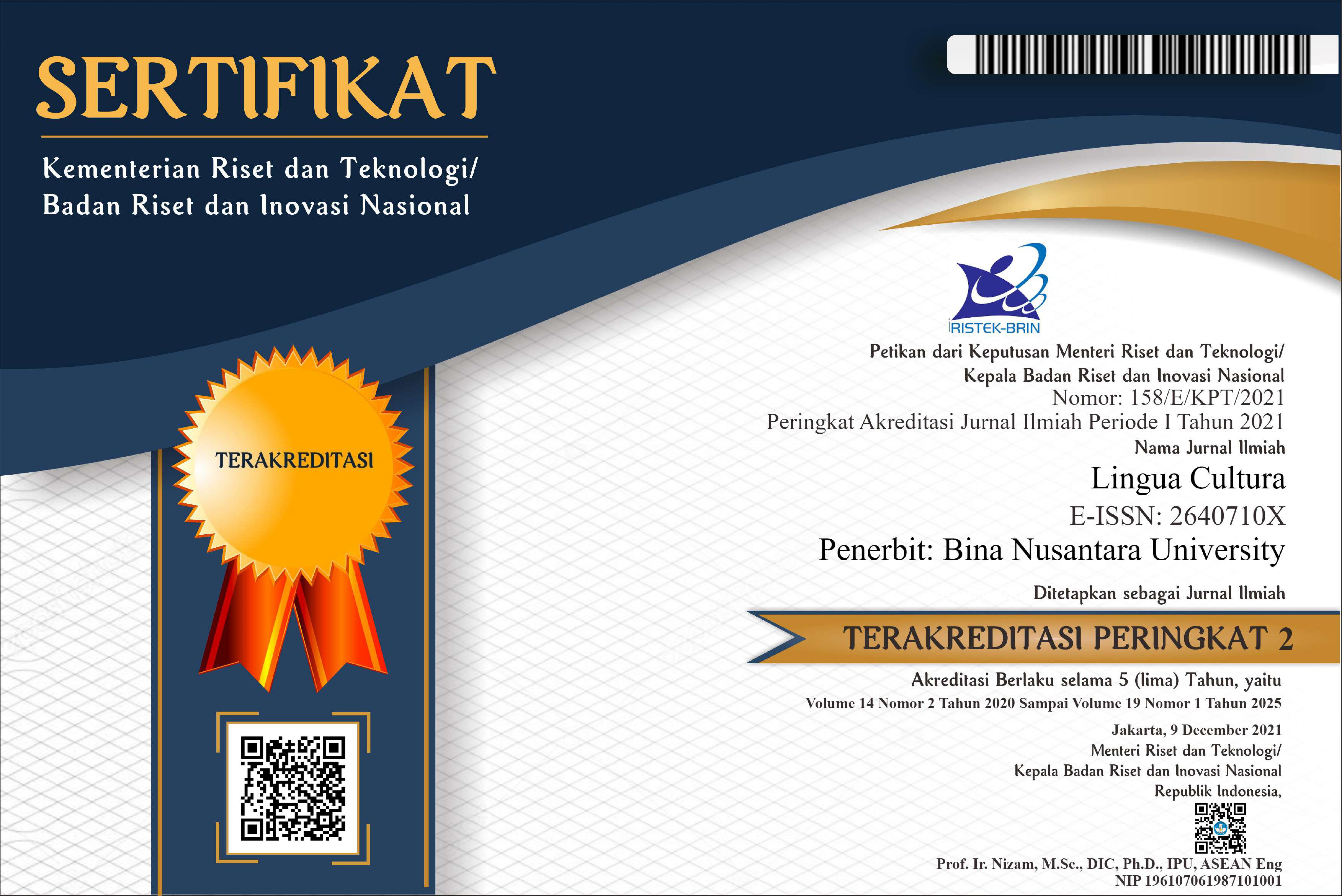The Form and Function of Local Language in Directive Speech Act at A University in Central Sulawesi
DOI:
https://doi.org/10.21512/lc.v10i1.848Keywords:
directive act form, function, directive act, local languageAbstract
The aim of this research was to describe the local language form, function, and typical of it in the directive act at the university in Central Sulawesi. The method used in this research was descriptive qualitative in socio-pragmatics approach. The source of the data was gained from lecturers and students utterances in discourse lecture. The data collection used note taking. Meanwhile, the techniques of analyzing data were the interactive analysis that consisted of four steps, namely data collection, data reduction, data analysis, and verification or drawing the conclusion. The result of the research shows that the local language form in directive act consisted of imperative, interrogative, and declarative. The functions of local language in directive acts are the prohibitive function, suggestive function, requestive, and permissive function. The typical local language that used is characterized by regional language and its dialect.Plum Analytics
References
Alwi, Hasan et al. (2003). Tata Bahasa Baku Bahasa Indonesia. Jakarta: Balai Pustaka.
Arani, S. (2012).A Study Of Directive Speech Acts Used By Iranian Nursery School Children: The Impact Of Context On Children’s Linguistic Choices. International Journal of Applied Linguistics & English Literature, 1(5), 163-175. doi:10.7575/
Ijalel.V.1n.5p.163
Beck, D. (2008). Character-Quoted Direct Speech in The Iliad. Phoenix: The Journal of The Classics Association of Canada, 62(1/2), 162-183
Beltran, E. V. (2014). Length os stay abroad: Effect of time on the Speech act of Requesting. International Jurnal of English Student, 14 (1), 79-96. doi: http://dx.doi.org/10.6018/ijes/14/1/155211
Chaer, A., & Agustina, L. (2010). Sosiolinguistik. Jakarta:
Rineka Cipta.
Cummings, L. (2007). Pragmatik: Sebuah Perspektif Multidisipliner. Yogyakarta: Pustaka Pelajar.
Field, M. (2001). Triadic Directives in Navajo Language
Socialization. Language In Society, 30, 249–263.
Fraser, B. (2005). Whither Politeness in Robin T Lakoff and Sachiko Id (ed): Broadening the Horizon of Linguistic Politeness. Amsterdam/Philadelphia: John Benjamin Publishing Company.
George, R. L, Jr. (2014). NSA Management Directive #424:
Secrecy and Privacy in The Aftermath Of Edward Snowden. Ethics & International Affairs, 28, 29-38. doi:10.1017/S0892679413000488.
Gunawan, F. (2014) Brown and Levinson’s Politeness
Representation in Academic Discourse. Kandai, 10(1), 16-27.
Bilbow, G. T. (2002). Commisive speech act use in intercultural bussiness meetings. IRAL International Review of Applied Linguistics in Language Teaching, 40(4), 287-303.
Haugh, M. (2011). Epilogue: Culture and Norms in Politeness Research. in Daniel Z. Kadar and Sara Mills (Ed.) Politeness in East Asia. New York: Cambridge University Press.
Ibrahim, A. S. (1993). Kajian Tindak Tutur. Surabaya: Usaha Nasional.
Leech, G.(1993). Prinsip-prinsip Pragmatik. Jakarta: UI Press.
Lohse, K.,Grafenhain, M., Behne, T., Rakoczy, H. (2014).
Young Children Understand The Normative Implications of Future-Directed Speech Acts. Plosone, 9(1), 1-9. doi: 10.1371/Journal. Pone.0086958
Mahsun. (2012). Metode Penelitian Bahasa: Tahapan Strategi, Metode, dan Tekniknya. Jakarta: Raja Grafindo.
Miles, B., Matthew., Huberman, A. M. (2014). Analisis Data Kualitatif. Translated by: Tjejep Rohendi Rohidi. Jakarta: UI Press.
Muhartoyo., Kristiani, K. (2013). Directive Speech Act in
The Movie “Sleeping Beauty”. Humaniora, 4(2), 949-966.
Prasetyo, A. (2010). Ngululu dalam Bahasa Jawa. Jurnal Kandai, 6(2), 151-161.
Prayitno., Joko, H. (2009). Tutur Berbahasa Pemimpin Dalam Wacana Rapat Dinas: Kajian Pragmatik Dengan Pendekatan Jender. Kajian Linguistik Dan Sastra, 21(2), 132-146.
Rahardi, K. (2010). Kesantunan Imperatif Bahasa Indonesia. Jakarta: Erlangga
Saddhono, K., Poedjosoedarmo, S. (2011). Wacana Khutbah
Jumat di Surakarta: Suatu Kajian Linguistik Kultural. Jurnal Pendidikan dan Kebudayaan, 17(4), 433-446
Saddhono, K. (2012). The Discourse of Friday sermin in Surakarta: A socio-pragmatics study. Jurnal Wacana,
(1), 145-153
Saddhono, K.,Wardani, N. E., & Ulya, C.(2015). A Sociopragmatic Approach on Discourse Structure of Friday Prayer’s Sermon in Java and Madura Island. International Journal of Language and Literature, 7(6), 26-29.
Searle, J. R. (1976). Speech Acts. New York, London: Cambridge University Press.
Shvartzman., Pesach., Reuven, Y., Halperin, M., Manahem, S. (2015). Advance Directives: The Israeli Experience. Journal of Pain and Symptom Management, 49(6),97–110. doi: http://Dx.Doi. Org/10.1016/J.Jpainsymman.2014.12.009
Sudaryanto. (2001). Metode dan Analisis Aneka Teknik Bahasa. Yogyakarta: Duta Wacana University Press.
Tarigan, H. G. (2009). Pengajaran Pragmatik. Bandung: Angkasa Bandung.
Thamrin. (2010). Ekspresi Tindak Direktif dalam Interaksi Kelas Bengkel Jurusan Teknik Mesin Politeknik Megeri Malang. LITERA, 9(1), 87-100.
Welvi, Y. A., Ermanto., Hasanuddin, W. S. (2015). Tindak Tutur Direktif Guru Dalam Proses Pembelajaran di MTs Riadhus Sholihin Koto Baru Kabupaten Sijunjung. Jurnal Bahasa, Sastra, Dan Pembelajaran, 3(1), 84-95.
Downloads
Published
Issue
Section
License
Authors who publish with this journal agree to the following terms:
a. Authors retain copyright and grant the journal right of first publication with the work simultaneously licensed under a Creative Commons Attribution License - Share Alike that allows others to share the work with an acknowledgment of the work's authorship and initial publication in this journal.
b. Authors are able to enter into separate, additional contractual arrangements for the non-exclusive distribution of the journal's published version of the work (e.g., post it to an institutional repository or publish it in a book), with an acknowledgment of its initial publication in this journal.
c. Authors are permitted and encouraged to post their work online (e.g., in institutional repositories or on their website) prior to and during the submission process, as it can lead to productive exchanges, as well as earlier and greater citation of published work.
USER RIGHTS
All articles published Open Access will be immediately and permanently free for everyone to read and download. We are continuously working with our author communities to select the best choice of license options, currently being defined for this journal as follows: Creative Commons Attribution-Share Alike (CC BY-SA)

















